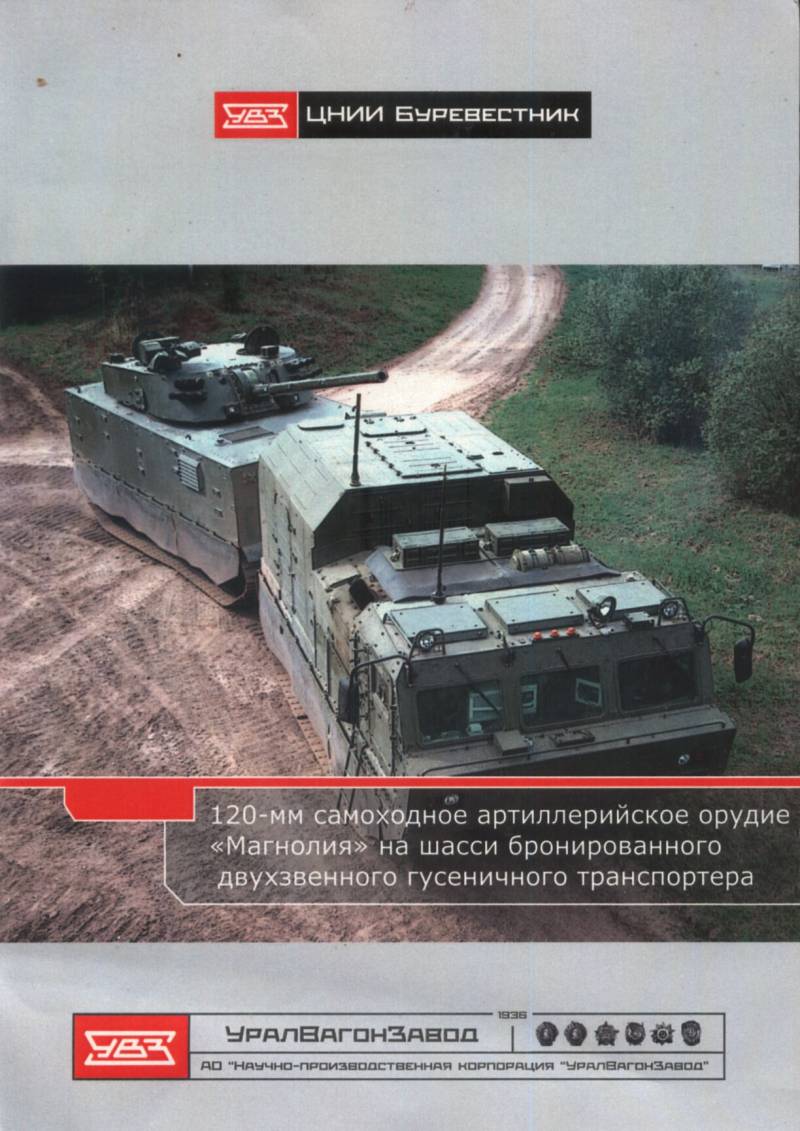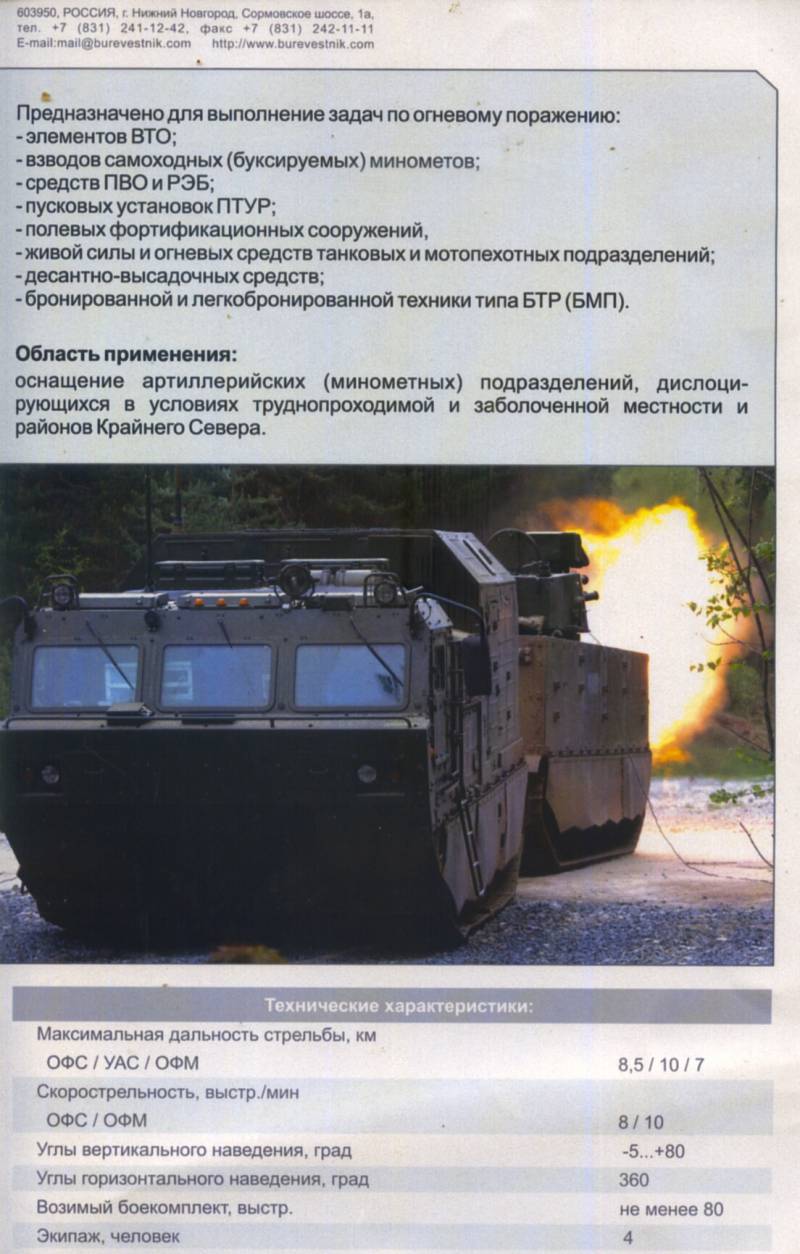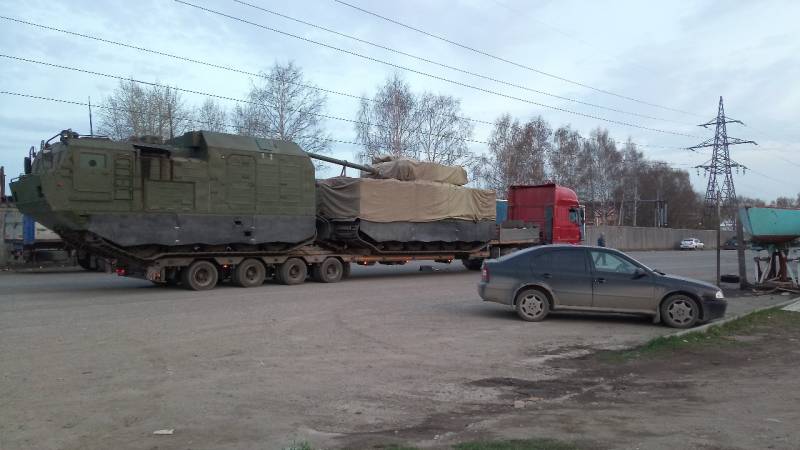Perspective CJSC "Magnolia". What is known about him?
Public information
For the first time, the existence of the CJSC Magnolia project became known in 2018. The New CAO was developed by the Nizhny Novgorod Central Research Institute Burevestnik together with two other samples as part of the development work with the Sketch code. It was reported that the project provides for the installation of a fighting compartment with an 120-mm universal tool on the chassis of a two-link tracked carrier. Such a combat vehicle was intended for artillery formations serving in the Arctic.
Last fall, it was reported that all the prototypes for the RCD "Sketch" had already passed into the final stage of testing. It was argued that in the near future they would have to go into the series and enter the troops.
At the beginning of May, the available data on the appearance of the Magnolia were supplemented with the first images. At the beginning of May, a couple of interesting photos appeared in open access. They depicted a two-link armored vehicle, the rear of which carried a turret with a gun. The rear link was closed with an awning.
At the end of June, within the framework of the “Army-2019” exhibition, the development organization for the first time presented promotional materials on Magnolia. The leaflet was attended by two new photos, as well as the objectives of the project and the main performance characteristics of the perspective sample. Thus, for the first time, it is possible to study real photos and numbers.
According to new data
CAO "Magnolia" has a distinctive appearance. For the first time in domestic practice, an artillery fighting compartment was mounted on a two-link tracked chassis. The basis for the self-propelled gun is a modified all-terrain vehicle DT-30PM “Vityaz” with a five-roll chassis on the front link and with a six-roll on the rear. The front case accommodates the driver's cab, powerplant units, etc. On the basis of the rear made fighting compartment.
Two-link chassis provides high throughput in difficult terrain. It allows you to work effectively in difficult and swampy areas - especially in the Far North. In addition, unification with other “Arctic” equipment samples has been provided. The chassis is equipped with armor and is protected from major threats.
The fighting compartment is installed on the back of the Magnolia - judging by the photo, it was borrowed from the self-propelled 2C31 “Vienna” self-propelled gun, but it has some differences. Above the hull stands the characteristic dome of the tower with an 120-mm gun and various devices on its surface. Main weapon fighting machine - a versatile weapon 2А80, combining the fighting qualities of guns, howitzers and mortars. The design of the tower provides a circular horizontal guidance and the rise of the trunk from -5 ° to + 80 °.
The instrumentation of the tower was not specified. The new photo shows that the “Magnolia” has no characteristic box-shaped casing with a panoramic sight, present on the “Vienna”. This indicates that, at the request of the customer, the composition of the onboard monitoring and fire control devices was changed in the new project.
According to the developer, the maximum firing range of the Magnolia reaches 7-10 km and depends on the type of ammunition used. When using 120-high-explosive fragmentation projectiles, the range of 8,5 km is reached, guided munitions fly by 10 km. Mines of caliber 120 mm are sent to 7 km. Ammunition includes at least 80 shots of all types. The rate of fire reaches 8-10 shots per minute.
The crew of the CJSC "Magnolia" consists of four people. Apparently, one of them is in the cockpit of the front case, while the others work in the fighting compartment of the second.
In promotional materials, the Magnolia task is fire destruction of a wide range of ground and surface targets. The gun can attack manpower and various enemy armored vehicles, air defense and anti-tank guns, artillery and missile systems, buildings and fortifications, amphibious landing craft, etc.
Augmented Picture
Thanks to fresh advertising materials, we can present the overall appearance of the promising IJSC Magnolia, as well as the characteristics and combat capabilities of this vehicle. In combination with already known data, recent reports allow us to make a more detailed picture, as well as to make certain assessments.
For the artillery units of the Arctic, the CAO is being created on an improved cross-country chassis adapted to the special conditions of the region. At the same time, the possibility of operating such equipment in other difficult areas is not excluded. The two-link transporters of the Vityaz family have already shown and proved their high potential, and also have been tested as carriers of weapons. Now all their advantages will be used to strengthen the artillery in remote areas.
In the fighting compartment, the new “Magnolia” is maximally unified with the existing “Vienna”. This in a known manner simplifies the construction and operation of advanced equipment. In addition, staff training is simplified.
Unification with the existing sample also allows you to retain all its characteristic advantages. Like other domestic systems of the “gun-shot” ballistic scheme, the new CAO “Magnolia” is able to use a wide range of ammunition of various types and different purposes, allowing to solve all arising problems. In fact, the gun replaces the guns for direct fire, as well as howitzers and mortars for firing from closed positions.
Thus, an artillery self-propelled gun is proposed for operation in the Arctic, combining the high mobility of a two-link chassis and a combat compartment with universal armament. An important consequence of this is the ability to solve various combat missions using only one type of equipment.
On the way to the troops
According to reports last fall, all three self-propelled guns of the ROC "Sketch" were being tested and were nearing completion. At the same time, the deadlines for the completion of such events were not specified. In recent days, it has become known that Magnolia and other promising systems are still being tested and are not yet ready for service.
How soon the advanced technology will complete the tests and receive a recommendation for adoption is unknown. It is also not entirely clear when a prototype or a serial model of Magnolia will be shown to the public and specialists. Two other representatives of the draft “Sketch” have already been demonstrated “in metal”, while the self-propelled gun on the Vityaz chassis is still shown only in the photo.
It will take some time to complete the current work, check and fine-tune the equipment, as well as launch the mass production. Over the next few years, new models will be able to enter service and begin service. All three CAOs from the Sketch project are built using curious ideas and solutions that enhance the tactical and technical characteristics.
According to the results of the “Magnolia” project, the Arctic units will receive a new self-propelled artillery self-propelled gun, which will give them a serious increase in firepower. In addition, in the future, such a model of equipment will provide a significant advantage over the likely adversary who plans actions in the regions of the Far North. In a hypothetical confrontation in the Arctic, the Russian army will have serious artillery arguments.
- Ryabov Kirill
- Central Research Institute "Burevestnik", Russianarms.ru



Information